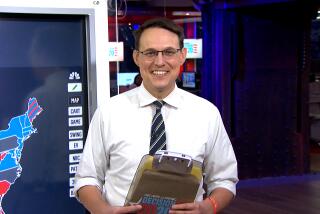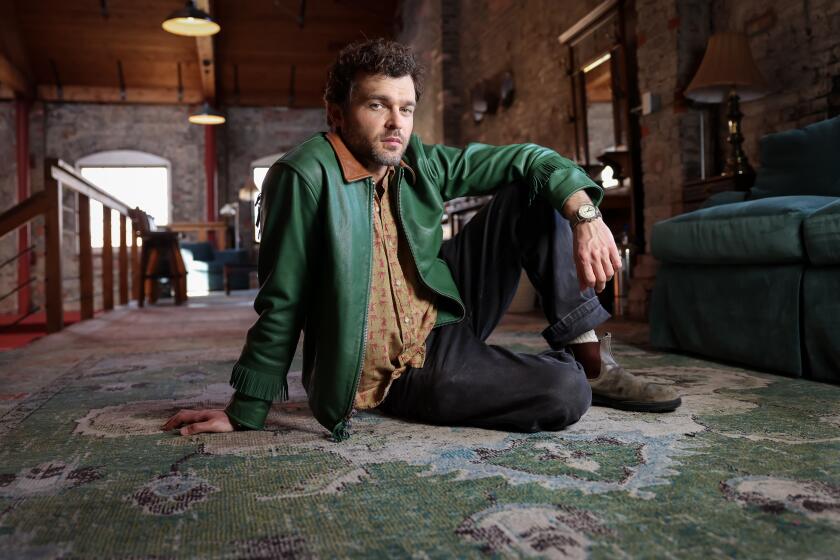Column: ‘Art as Protest’ paints grim headlines
- Share via
What happens when reality catches up to art? Is the art less impactful?
There is an “Art as Protest” exhibit at the Orange County Center for Contemporary Art in Santa Ana that forces viewers to confront basic questions about art and social commentary.
For example, as I stood in front of two dystopian pieces by Florida artist Don Manderson, I wondered why I wasn’t particularly shocked.
Clearly, the pieces are grim, portraying unbridled militarism and rampant, plague-like illness, but there also is a normality to them.
It was as if all the TV bombardment we get – the zombie shows, the blood baths, the political tripe – has created a new normal that is inherently fantastical yet believable.
We simply don’t blanch anymore. We accept the most outrageous images and statements without blinking.
Protest art, therefore, can be seen on any news channel, 24 hours a day.
To some extent, Manderson, like several other artists at the exhibit, expect this and embrace the timeliness challenge.
“The term that most accurately describes my current work is ‘simultaneity’ (the simultaneous and insistent nature of the human sensory experience in an increasingly technical society),” Manderson wrote in describing his work.
Manderson believes that this phenomenon relies on the pervasive social interaction that humans face through “advertising, entertainment, journalism and as emulated in the arts.”
The impact is unsettling once a viewer realizes that what they’re looking at is not normal, yet they’re treating it as such. It’s an effective subversion.
The curator of the exhibit, Tyler Stallings, has managed to bring in pieces that at times seem collegiate but still work because of the current political climate.
Not surprisingly, President Trump is a frequent target but once you get beyond the exaggeration, there are some clever treatments. Several artists elevate the message to make a broader and more global point.
Generally speaking, in addition to the outrage, there is a subtle sense of embarrassment in the exhibit, as if the artists are apologizing to the world for the current plight of the U.S.
In describing the exhibit, Stallings admitted that the globalism theme was front and center in his mind as he curated the pieces.
“Today, migrations of people are the norm, along with migrations of capital and information,” he wrote. “The only map that may make sense anymore is one that depicts these migrations as overlapping flows whose borders alter constantly.”
This fluid globalism creates built-in tension for artists trying to articulate a dynamic world view.
“How can you protest in a disorienting world of shifting power and authority, whereby states, corporations, and their human faces become indecipherable from one another, to the point that the beating hearts of due process, freedom of speech, and the right to assemble begin to lose their strengths?” Stallings asked. “Well, by being an artist and not letting your voice become subsumed under the sediments of an alluvial plain of dehumanization where these globalized flows meet on occasion.”
Stallings currently serves as the artistic director at UC Riverside’s Culver Center of the Arts and the Sweeney Art Gallery. He has also organized exhibitions as program director for the Huntington Beach Art Center, and as chief curator at the Laguna Art Museum.
There are more than 75 artists in the exhibit, which runs until July 8.
With weekend resistance rallies and nightly stories of conflict, protest art is everywhere, but if you want to see it up close in a thoughtful collection, check out the OCCCA.
It’s probably the closest you’ll get to real-time protest art.
What was interesting for me was not the political statements, per se, but the ominous overtones of where we are going as a culture.
If art portends life, which it usually does, the landscape does not look pretty.
Orange County Center for Contemporary Art is at 117 N. Sycamore St., Santa Ana. For more information, call (714) 667-1517 or visit occca.org.
DAVID HANSEN is a writer and Laguna Beach resident. He can be reached at hansen.dave@gmail.com.
More to Read
The biggest entertainment stories
Get our big stories about Hollywood, film, television, music, arts, culture and more right in your inbox as soon as they publish.
You may occasionally receive promotional content from the Los Angeles Times.










